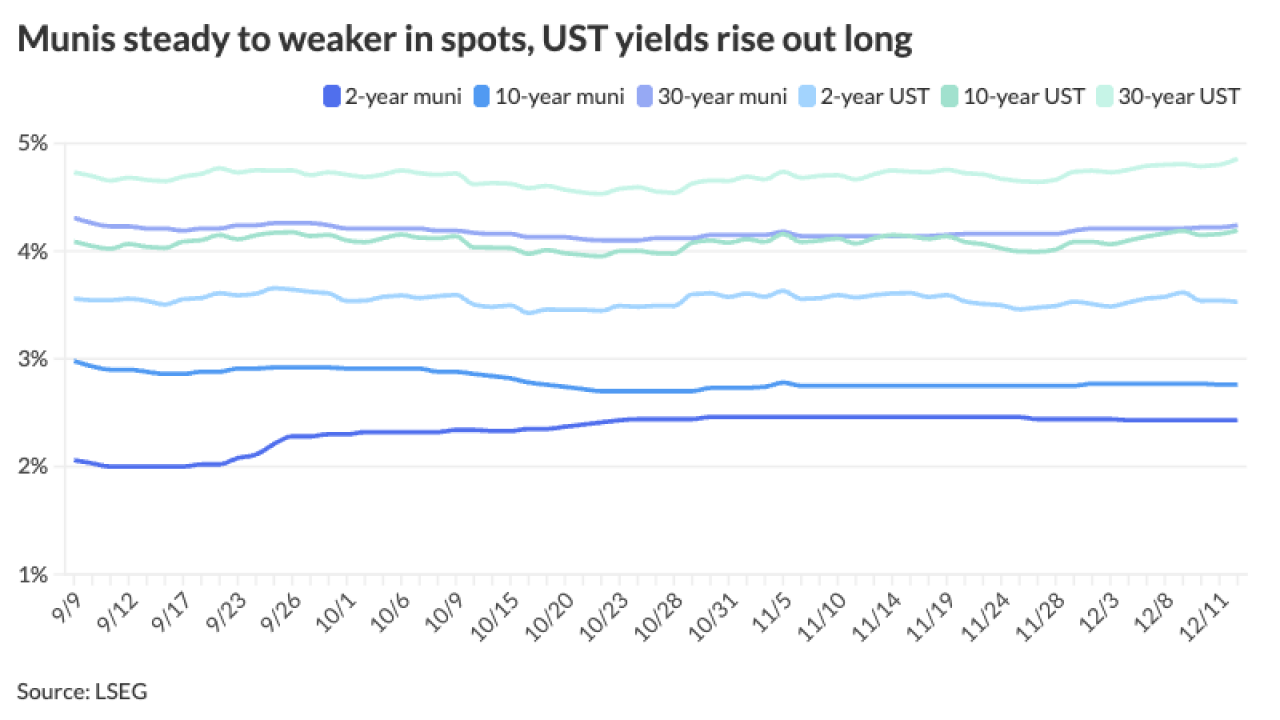NEW YORK ¯ It was another typical Monday in Muniland despite Goldman, Sachs & Co. once again postponing one of the biggest deals of the season.
Goldman was expected to sell $900 million of fixed-rate revenue bonds for the Liberty Development Corp. this Wednesday, to be followed by a $375 million variable-rate sale in the coming weeks when the fixed-rate portion closed.
The deal was originally priced for December but got delayed because of a spike in yields.
Goldman sought to get around the rise in yields by issuing part of the deal with variable-rate notes. A spokesman from the bank declined to comment on why the deal was postponed once again, but a variety of traders said the gridlock environment of the market remains unappealing for issuers.
“Expect zero, get zero,” is how one trader in California summed up Monday’s trading session. She said she wasn’t surprised the Liberty deal was shelved.
“When there’s an abundance of bonds, levels are all over the place,” she said, indicating that an abundance of supply offers more opportunities. “Right now, there’s just no mix. The new issuance is zero. It makes pricing unattractive.”
Yields have risen considerably since the Liberty bonds were first postponed. The Municipal Market Data 20-year yield, for instance, began December at 3.97% and has since risen to 4.39%.
It’s unclear when the Liberty bonds will now be priced, but Goldman said it will provide clarification Wednesday.
So far, the delay did not appear to have any impact on the market.
“It’s going to take more than that to affect yields,” said a trader in New York, who called Monday’s session quiet.
“I don’t think it’s affecting the market one way or another,” said another trader in New York. “The fact that it might be postponed didn’t even enter my head. My feeling is, so what?”
He admitted he was curious to know what happened with the issue, but added that nobody was talking.
“There’s no new cash to put to work,” added a third trader in New York. “Yields are going to back off and stay steady, but given the light supply, we’ve seen sideways movement today.”
The MMD scale remained steady on all points of the curve Monday.
But the general trend remains one of rising yields, particularly in the belly of the curve.
MMD’s 10-year yield jumped 37 basis points from 2.90% on March 16 to 3.27% on Friday, while the 30-year yield rose 26 basis points to 4.65%.
Most traders believe yields will keep rising, particularly if heavy supply finally returns to the market.
“There’s very little question that an additional yield adjustment will be required beyond what has already transpired to move an uptick in supply,” wrote John Dillon, chief muni bond strategist at Morgan Stanley Smith Barney, in a research note published Friday. “But we suspect that the majority of this 'anxiety discount’ has been priced into the market.”
He said the quality and location of upcoming supply may impact prices more heavily than the par amount. Treasury rates too, could provide more direction.
Shorter-term tax-exempt bonds continue to see heavy demand. Despite rising yields among Treasuries, one-year muni paper has remained at 0.32% since March 15. During that period, their value relative to Treasuries has fallen from 160% to 128%.
“You don’t have so much interest rate risk there,” said the third trader in New York, suggesting traders are parking their money until new supply hits the market. “The bids we’ve seen, they’re getting ready to sell off the runs and getting ready to buy the new deals. That will be your trading activity.”
While muni yields were steady Monday, Treasuries were mixed. The two-year Treasury ticked up one basis point to 0.83%, while the 10-year yield firmed one basis point to 3.58% and the 30-year yield held at 4.65%.
Most traders continue to suggest that, unless the Treasury market rallies for some unforeseen reason, tax-exempt yields will rise once a decent batch of supply hits the market.
“The market remains thin and lacking in conviction, with the lack of new-issue supply making price discovery particularly difficult,” wrote George Friedlander, head of municipal strategy at Citi, in a research note published Friday.
He also noted that long-term revenue bond issuance fell 59% through the end of March, serving to alleviate potential pressure that bond fund outflows and retail fears of long-term munis have caused.
Friedlander pointed out that five-year tax-exempts, offering 1.79% according to MMD, are looking particularly over-valued. The five-year tax-exempt offered 77.8% of the comparable Treasury rate Monday, compared to a 12-month average of 84.1%. It offered 89.3% of comparable Treasuries on March 16, when its yield was 1.67%.
The 30-year muni, by contrast, is relatively cheap: it offers 105% of the comparable Treasury rate, about five percentage points higher than the 12-month average.
The new-issue market was slim. The only sizable deal was a three-series issue totaling $74 million for Dallas County, Texas. The deal was rated triple-A by Moody’s Investors Service and Standard & Poor’s, with yields ranging from 0.42% in 2012 to 3.49% in 2021.
Siebert Brandford Shank & Co. priced the deal, offering unlimited tax refunding bonds, limited tax refunding bonds, and limited tax notes.
Traders have been saying that high-grade bonds can be priced without much trouble in this environment, but lower-grade issuance have a difficult time getting priced.
Including the Liberty deal, The Bond Buyer and Ipreo calculated that $4.35 billion was to hit the market this week, versus the $2.6 billion last week. First-quarter issuance averaged roughly $3 billion per week, well down from the $8 billion average last year.
A trader said digesting deals this week shouldn’t be difficult, provided they are appropriately priced.
“If it’s the right level, it going to get digested. If not, it will get hung up,” he said.
But he said lower-grade deals from last week continue to tie up the market.
“We have to wait and see what happens with those,” he said. “Not everything is going away so people are going to focus on that. If all of a sudden everything starts to go away, it will be okay; if it doesn’t, the market could get weaker.”





